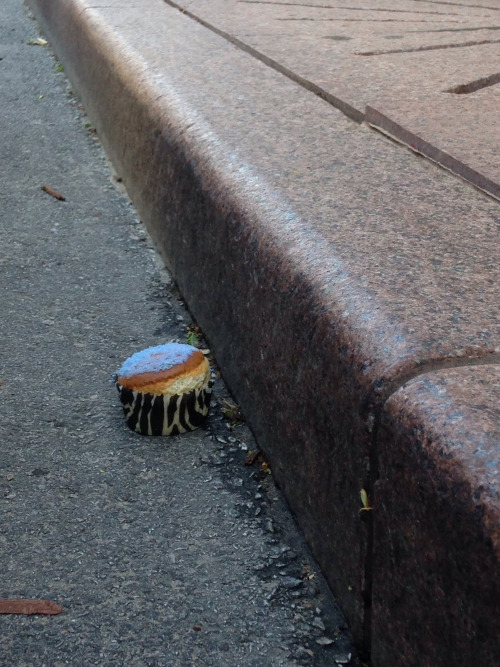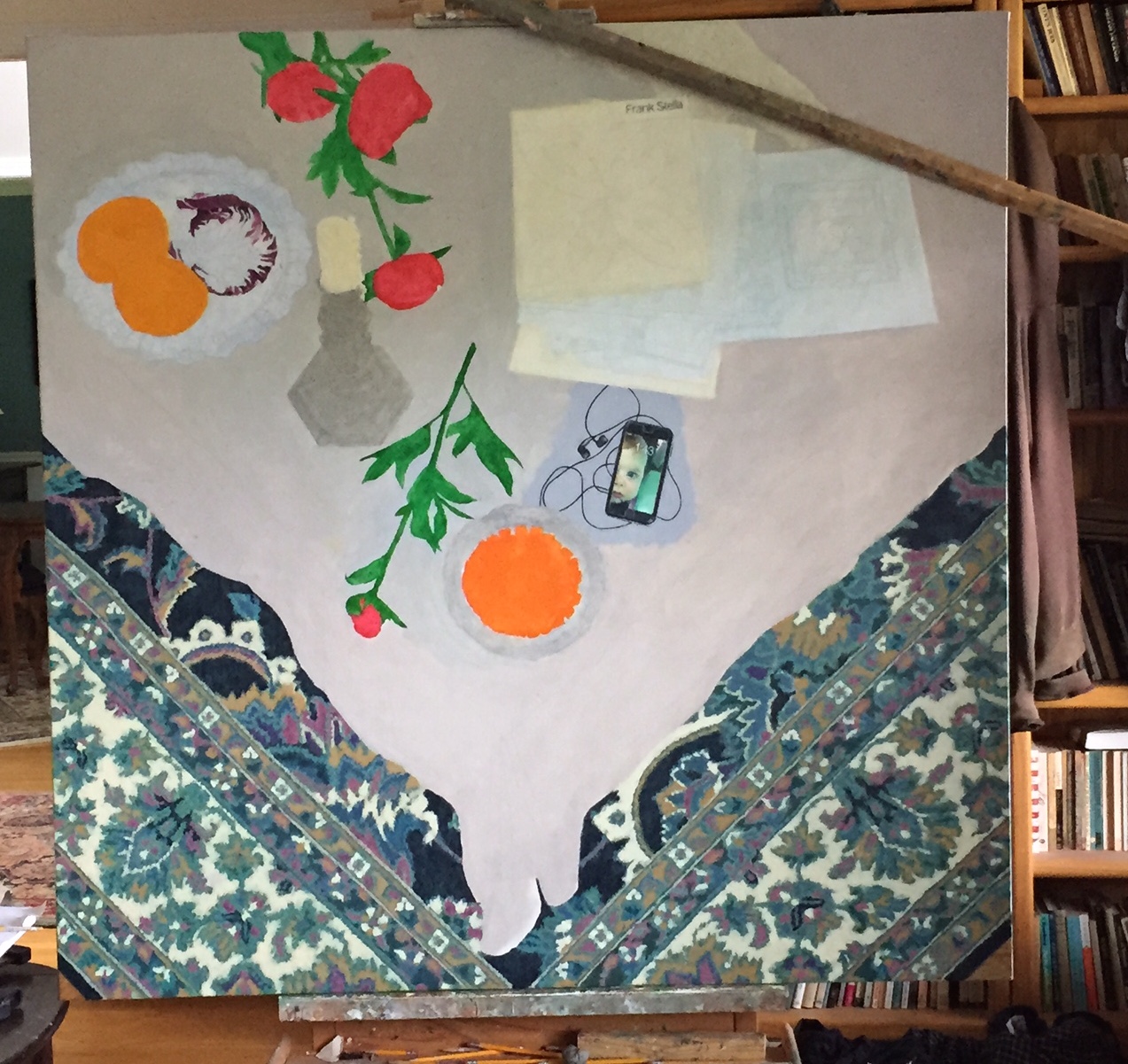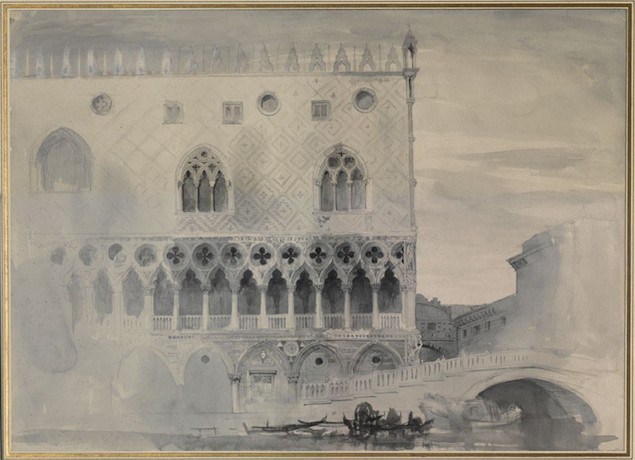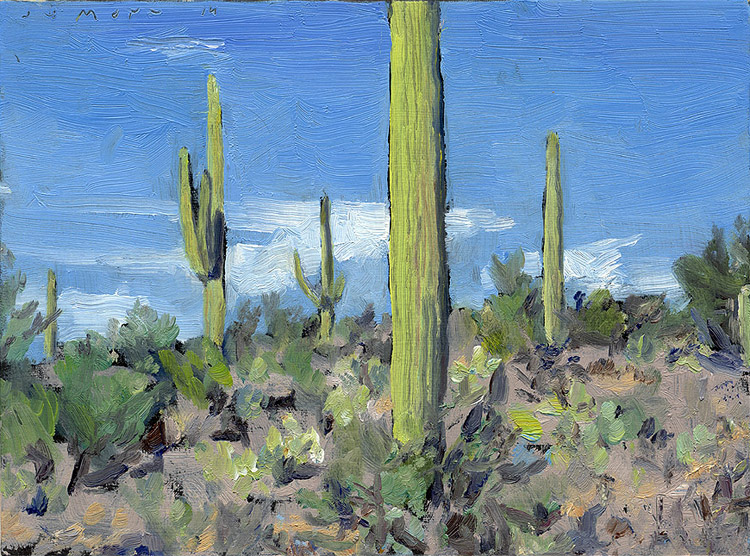Archive for June, 2015
Slow and steady
After my last show at Oxford, I decided to tackle the most ambitious painting I’ve ever done. It’s another in the series of tabletops I’ve been doing for a long time–I did the first one, back in the 90s. Why I keep returning to the format isn’t entirely clear to me, other than to say I don’t feel I’ve exhausted the rewards this template, with its unusual downward-looking perspective, a literally bird’s-eye view of a tabletop. What’s unusual, this time, is how long I expect to work on the painting. First, I’m going to spend more time on each part of this painting than I have before, developing the image as slowly as it requires, so that every element gets as much attention as all the rest. I’ve already put about six weeks into it and don’t expect to be done until the fall, partly because the summer always pulls me away from the easel for several weeks every year, but mostly because it’s a set of complex objects requiring gradual, painstaking development. While I’m doing it, I’m going to try to clarify to myself how and why I started doing this sort of image, why it allowed me to absorb certain influences and incorporate them into my own work, and what sort of meaning the images seem to have, even though I have been creating them simply as a way of addressing formal challenges, not conceptual ones. My blog output is likely going to lighten up since my energy goes first to this painting, and hopefully some small ones I’ll be able to do along the way as I finish this. That’s Poppy, the newest member of our clan, peeking out at you from inside my iPhone.
Paying attention
There’s an interesting overview of how John Ruskin took the perception of beauty as a foundation for social reform here. His drawings are exceptional; the ones of Venice remind me of Canaletto. I’m not sure I share his view of beauty and his passion for reform: the perception of ugliness often means you aren’t seeing what’s actually there. There’s delight in reading Salinger’s catalog of a medicine chest’s contents in Franny and Zooey, but I doubt it would have passed the Ruskin test for beauty. But he seemed to value the act of paying attention as the root of what’s good in life, and art was a way of practicing it.
So Ruskin thought it helpful for us to observe and be inspired by nature (he was a great believer that everyone in the country should learn to draw things in nature). He wrote with astonishing seriousness about the importance of looking at the light in the morning, of taking care to see the different kinds of cloud in the sky and of looking properly at how the branches of a tree intertwine and spread. He took immense delight in the beautiful structures of nests and beavers’ dams.
True blue
A finely written piece, again from The Paris Review, from a young Rochester novelist on how costly ultramarine paint once was. It’s fascinating how an artist using cheaper substitutes would be taking terrible career risks. Now it’s one of the less expensive paints, something I use constantly but mostly to mix with raw umber to get an equivalent for very dark grays and a substitute for black. There are some inspiring paeans to ultramarine here, though the great poet of blueness is missing: the German scientist, Novalis and his “blue flower,” the symbol of German Romanticism. Yet for me, ultramarine isn’t “true blue.” It’s a blue that leans toward purple, and you’ll find it far more often in nature than a purely neutral blue, which I’ve found nearly impossible to locate out in the world. In our garden, I’ve seen what I considered a pure blue only once in a delphinium that survived our winters only a couple years and was impossible to find again. There was almost no trace of green or red in its blue flowers. Blue has no more appeal for me as a color than anything else in the spectrum, yet it was amazing to see blue, and just blue, itself out there in the yard, rather than some commonplace blue tinted toward of violet or purple, as ultramarine is. From the essay:
Michelangelo couldn’t afford ultramarine. His painting The Entombment, the story goes, was left unfinished as the result of his failure to procure the prized pigment. Rafael reserved ultramarine for his final coat, preferring for his base layers a common azurite; Vermeer was less parsimonious in his application and proceeded to mire his family in debt. Derived from the lapis lazuli stone, the pigment was considered more precious than gold. For centuries, the lone source of ultramarine was an arid strip of mountains in northern Afghanistan. The process of extraction involved grinding the stone into a fine powder, infusing the deposits with melted wax, oils, and pine resin, and then kneading the product in a dilute lye solution. European painters depended on wealthy patrons to underwrite their purchase. Less scrupulous craftsmen were known to swap ultramarine for smalt or indigo and pocket the difference; if they were caught, the swindle left their reputation in ruin.
Unfinishing it
On my recent visit to the home and studios of Bill and Jean Stephens, I got a look at a wall full of work Bill has been doing. The little grove of trees (where Jean built her human-sized nest of branches and twigs) fascinates Bill, and he’s been doing an extensive series of paintings and drawings inspired by it. Recently, he took a small suite of these paintings and sanded them down, erasing upper layers of the paint and revealing far more abstract and beautifully colored areas underneath: from representation back to abstraction with a technique that almost fits into the Japanese gutai sense of letting the erosion of materials become an essential part of how a work of art will turn out. In this case the erosion is intentional. I really like what he’s ending up with, though he may be tempted to reverse course and start finishing things more. But unfinishing a painting is an interesting idea. Take it back in time to something that wasn’t actually visible at any point along the way.
Landscape lottery
Jim Mott, my friend the itinerant painter, has modified his M.O. just slightly. He’s an itinerant painter who now, sometimes, becomes a . . . hm. . . sojourning painter, I guess. Not to put too fine a point on it, technically speaking, he goes somewhere now and hangs around longer. Until lately, he’s been doing very long-distance laps for the sake of his painting. He’s a soul with a stopwatch ticking for the act of seeing (which is life, isn’t it)? He usually goes to a faraway place, like Washington state, and then comes home slowly, like Odysseus (but without nearly as much bloodshed along the way), through Idaho and Colorado or whatever, Wyoming, say. He stays with people who feed him in exchange for a painting of their surroundings. No money changes hands. Only hospitality for a tribute to the ordinariness of the place.
In Arizona not too long ago, he tried a new tack. He stuck around for a month and did minature Joseph Campbell day-trips out and back, over and over again, right around Tuscon. He came home to Rochester with shots of some fresh work, and I told him I thought it opened up a new way of exploring his relationship with people and landscapes far from home. Every day he would generate a new GPS point on the map, using a computer–would this count as some kind of self-fulfilling sortilege? I hope so. It would be cool and James Merrill-y to think of it that way, but it was digital divination as Stanley Kramer might have filmed it: his lottery delivered him to the runway of an airport one day and a dried-up aqueduct on another. (Go to the train station and paint it, Charles Hawthorne told his students. Go to this ditch and paint it, Jim’s computer told him.) Sticking to plan and principles, he got out his paints and looked hard. Which means the looking is much easier and rewarding, for all the rest of us, now that he’s back. I’ll never think of my Garmin app in the same way again.
Squaring the circle
Some of my favorite paintings by Jean Stephens are the ones she’s done of bird’s nests. I recently visited her home and studio, where she lives and works with Bill Stephens in Honeoye Falls, south of our home in Pittsford–I spent most of my time talking with him and Bill Santelli. It’s a fantastic place, secluded at the end of a private lane, with an artificial pond infiltrated by rushes and cattails, bird houses everywhere, and a long slope that descends from behind their place to a small grove of neatly, evenly spaced trees. In this little copse, Bill rakes the leaves into long, sinuous mounds that meander around like the paths of enormous moles. Jean has been taking all the dead limbs and twigs and building a human-scaled nest. I wanted to take it home and curl up inside it.
Reverence for the everyday
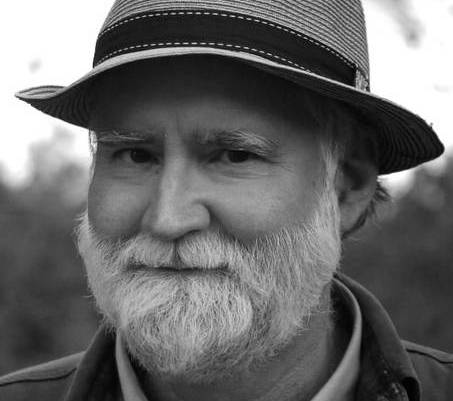 The Mezzanine is one of my favorite novels, which is why I like to think of Nicholson Baker as a Rochester homeboy. The entire novel took place on an escalator that once existed downtown here. From the intro to an interview with Baker in The Paris Review:
The Mezzanine is one of my favorite novels, which is why I like to think of Nicholson Baker as a Rochester homeboy. The entire novel took place on an escalator that once existed downtown here. From the intro to an interview with Baker in The Paris Review:
Few other authors would notice, as Baker did in The Mezzanine, that late-twentieth-century American men trying to pass through a door at the same time always say “oop” to each other instead of “oops.” After some twenty-five years of writing, Baker’s reputation is as unusual as his work. He has been praised, widely and enthusiastically, for his style, humor, originality, and empathy. (As Martin Amis once put it, “Throughout his corpus there is barely an ordinary sentence or an ungenerous thought.”) At the same time, some critics have very publicly loathed a handful of his books, most vociferously Vox(“tedious”), The Fermata (“repellent”), Checkpoint (“scummy”), and Human Smoke(“childish”). Many of Baker’s talents are self-consciously small: meticulously inventive phrasemaking, a masterfully intimate tone, and a superhuman gift for observation. He has a Dutch-painterly reverence for everyday rituals and objects—a belief that they will start to glow with significance if we only pay close enough attention. This has left Baker open to the charge that the work itself is trivial, quaint—a bubble of old-fashioned belletrism floating through a harsh modern world. (Leon Wieseltier, writing in The New York Times, once called Baker’s novels “creepy hermeneutical toys.”)
What’s disguised by Baker’s cheerful tone, however, is his passionately sustained conviction that we should honor the details of our lives rather than getting carried away by projections and abstractions. In this quest, Baker has seemed continually willing to risk puzzling his fans and inflaming critics; he has shown an indifference to publishing fashions that few authors could have sustained. One index of this independence is that, although Baker has been published for his entire career in magazines such as The New Yorker and The Atlantic, he has never held a staff position. “I felt I had to be someone who would leap in from outside,” he told me, “and do some nutty thing and then run away cackling.”
Baker is fifty-four years old, but you can still see the teenager in him: he is self-consciously tall and shy, and his face turned red, often, when we talked about his books. He lives in a rambling eighteenth-century house on the border of Maine and New Hampshire. We spoke there for several hours, first in the kitchen and then in the living room, next to the fireplace in front of which he wrote A Box of Matches. Later, Baker drove me to a restaurant in Portsmouth, New Hampshire, where, as we entered, a man exiting at the same time very distinctly said, “Oop!”
